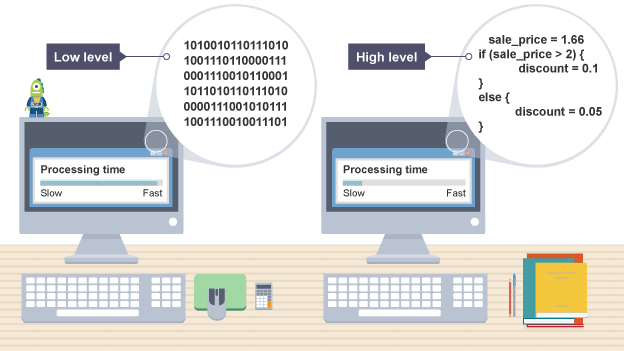
Knowing the difference between high- and low-level programming languages may seem a bit daunting, but it has value when you are working in both environments.
Today, we write most programs in a high-level language like C, Perl, or Java. Just as human languages make it simple for people to communicate with one another, computer languages make it simple to tell a computer what to do. However, because a computer only understands numbers, conversing with one is equivalent to chatting with someone you do not share a language. To properly communicate, you need a translator, which interpreters and compilers provide.
You can find the difference between an interpreted and a compiled language in the interpreting or compiling process outcome. An interpreter generates a program result, whereas a compiler generates an assembly language program. The architecture assembler then converts the resulting program to binary code. The assembly language used by each computer differs depending on its architecture. As a result, compiled programs can only run on computers with the same architecture as the one they were compiled.
A compiled program is not human-readable?
A compiled program is not human-readable; it gets written in an architecture-specific machine language. Creating a compiled program entails several steps. First, the programmer writes the source code in a chosen computer language using a development tool or a simple text editor. If the program is complex, you should divide it into several files. The programmer then compiles the program, sorting and linking the modules and translating everything into machine code that the computer can understand.
Because different types of computers do not understand each other's machine languages, a compiled program will only run on the platform for which it gets created. A program written for Windows, for example, in the past, would not usually work on a Mac OS or Linux computer. Despite this disadvantage, compiled programs are faster than interpreter-based programs. Furthermore, it is frequently possible to recompile the program to run on different platforms. C, Fortran, and COBOL are examples of languages we commonly used to create compiled programs.
In contrast, the source code is typically the program in an interpreted program. This type of program (also known as a script) necessitates an interpreter, which parses the commands in the program and then runs them. Some interpreters, such as the Unix, read and then run each command immediately. In contrast, others, such as Perl, analyze the entire script before sending the corresponding machine language instructions. A script can be very portable, and any computer with the appropriate interpreter installed can run the program in its entirety. This process is also a disadvantage because the program will not run at all if the interpreter is not available. Interpreted programs are commonly slower than compiled programs, but they are easier to debug and revise. JavaScript and Python are two other examples of interpreted languages.
Programs for runtime environments ranged from intermediate to computer-specific compiled programs and interpreted scripts. This behavior is how Java and Smalltalk programs execute. Writing programs for runtime environments is similar to writing classically compiled languages. Instead of compiling the source into a machine language, it is output into byte code for the "virtual machine" of the runtime environment. The byte code instructions are intercepted and translated into computer-specific commands by this virtual machine. The benefit of this approach is that runtime environments quickly compile only the required code (at least some parts of the program may never need to execute). This process is known as just-in-time compilation. The main disadvantage of runtime environments is that poorly designed programs force the runtime environment to compile all the code ahead of time and then make repetitive calls to the interpreter. This behavior causes the program to load and run more slowly.
In modern software development, we should make every effort to learn about both frontend and backend development languages. The importance of knowing the difference between high-level and low-level programming languages may seem a bit daunting, but it has a value when you are working both environments.
